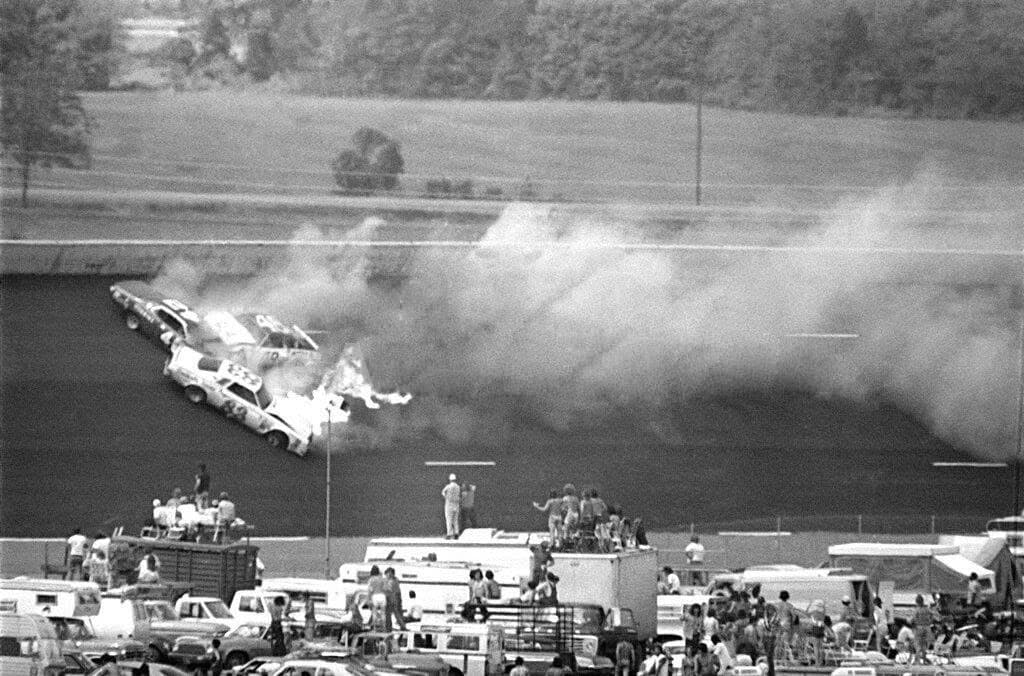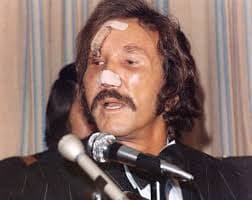
Today, if you walk into the NASCAR Hall of Fame in Charlotte, among the hundreds of glamorous photos of legendary drivers, you’ll find a small frame hanging quietly in a corner. No spotlight, no bold nameplate. Just a man in a black tuxedo, a smile warm as an autumn afternoon, and a long stitch running from his temple down to his jaw. A photograph that seems ordinary — but to fans, it’s the kind of moment that makes every heart tighten.
That man is Marty Robbins, America’s country music star, the one who once enchanted all of Nashville with a voice soft as an evening lake and timeless cowboy ballads. But that night, in that photograph, Marty wasn’t a singer on stage. He was a man who had just walked away from death — and still chose to stand up and smile.
The horrific crash at the Charlotte 500

The day of the Charlotte 500 in October 1974 began like any other major race: engines roaring, the smell of burning rubber thick in the air, and thousands of eyes fixed on the track where 800-horsepower machines flashed by like lightning.
At that moment, Marty Robbins wasn’t just a singer; he was an amateur driver fueled by pure passion, always ready to throw himself into speed as if he were born for it. For years, he had competed alongside professional drivers — and they, in return, held a quiet respect for him. Not because he was famous, but because he carried the heart of a true racer.
That day, in the final lap, Marty was holding a steady mid-pack position when suddenly a car ahead of him lost control. In that split second — the one every racer knows too well, where the distance between life and death is no more than the turn of a wheel — Marty made a choice no one expected. Instead of slamming the brakes and hoping to avoid the chaos, he pulled to the right and sent his own car into the wall, giving the other driver room to escape.
The impact thundered like a storm. Marty’s car skidded violently, the body crumpling, a tire tearing free from the rim. When the crew rushed over, the door had to be pried open with a crowbar — it was jammed shut from the crash.
A track doctor later recalled, “I’ve seen a lot of wrecks, but what stayed with me was his eyes. No fear. No panic. Just — ‘Was anyone else hurt?’”
Medical report: a shattered collarbone, two cracked ribs, and his face stitched with a total of thirty-two stitches, stretching from his temple all the way down to his jaw.
Doctors said he would need weeks to recover. But they didn’t understand Marty Robbins.
The man returned after just a few days

Three days after the accident, at an elegant event in Nashville — a fundraising gala mixed with performances — guests began whispering. Someone had just walked into the grand hall with a slightly stiff gait but a bright, unmistakable smile. It was Marty. A perfectly fitted black tuxedo, a crisp white bow tie, hair neatly combed. But what made everyone fall silent was the fresh scar. The long line of stitches, not yet fully healed, still a little red. Under the warm yellow lights of the room, it stood out even more.
A close friend of Marty later recalled: “I wanted to cry when I saw him. But he just smiled — that classic Marty smile — as if he had simply slipped on the floor, not slammed into a wall at 160 miles an hour.”
Marty refused to sit at the VIP table. He walked around greeting everyone, shaking hands with fans, checking in on backstage staff. Someone told him he should be resting. He waved it off: “I’m alive. That’s reason enough to be here.”
Then something happened that moved all of Nashville. A young girl — a devoted fan — shyly raised her camera and asked for a photo. Marty didn’t hesitate. He gave her the biggest smile of the night.
In that moment, the timeline of country music seemed to pause for a beat.
Just days later, the photo appeared everywhere: music magazines, sports papers, even pinned on bulletin boards at gas stations along the highways. Not because of the accident — but because it showed a man standing tall after nearly sacrificing himself to save someone else.
What did people see in that photo? Not the injuries, but the courage. Not the pain, but the calm. And above all — the resilience that made everyone admire him.
Why did the photo break every fan’s heart?
Because they knew who Marty Robbins was. He wasn’t just the singer of “El Paso,” “Big Iron,” or “My Woman, My Woman, My Wife.”
He was the man who would collapse backstage from exhaustion, yet still walk out with a smile — as if the audience were the greatest gift life could offer.
He was the man who bled on the racetrack but always said with humility, “I just did what needed to be done.”
He was the kind of person for whom kindness was instinct.
So when fans saw him in that photo — handsome, strong, but scarred — they understood that the price of courage is sometimes your own body.
And for a fleeting moment, millions realized: to become a hero, sometimes all you have to do is stand back up in the right place at the right time.